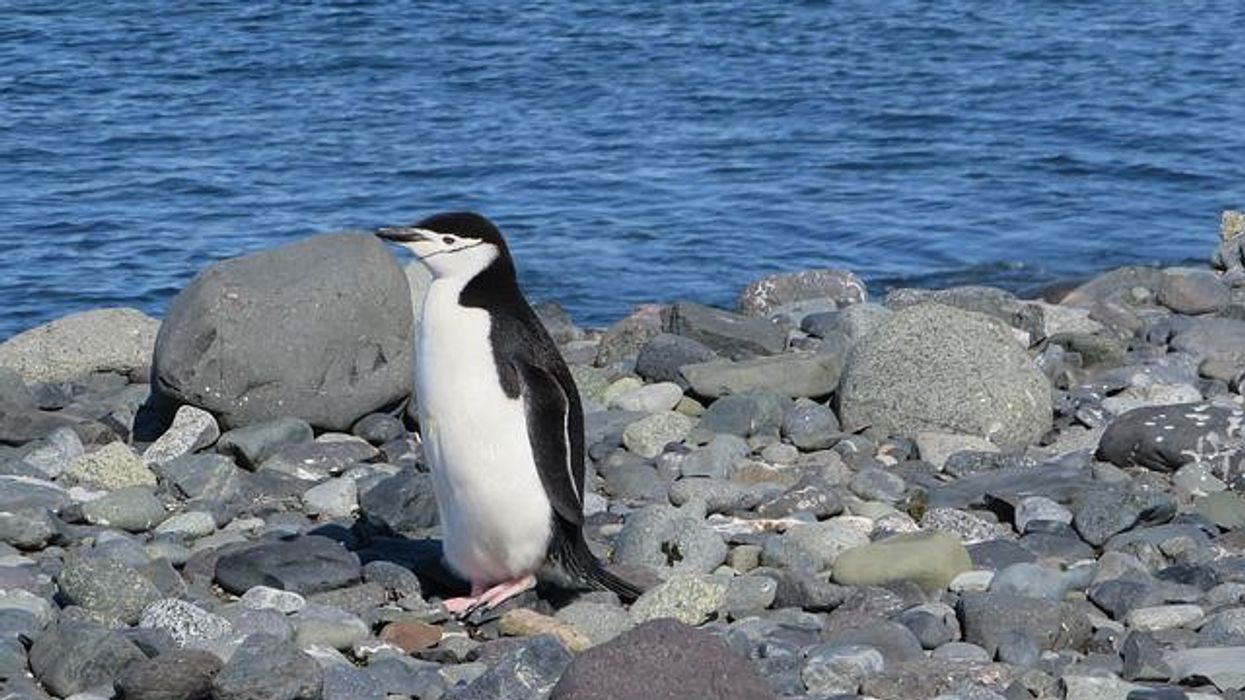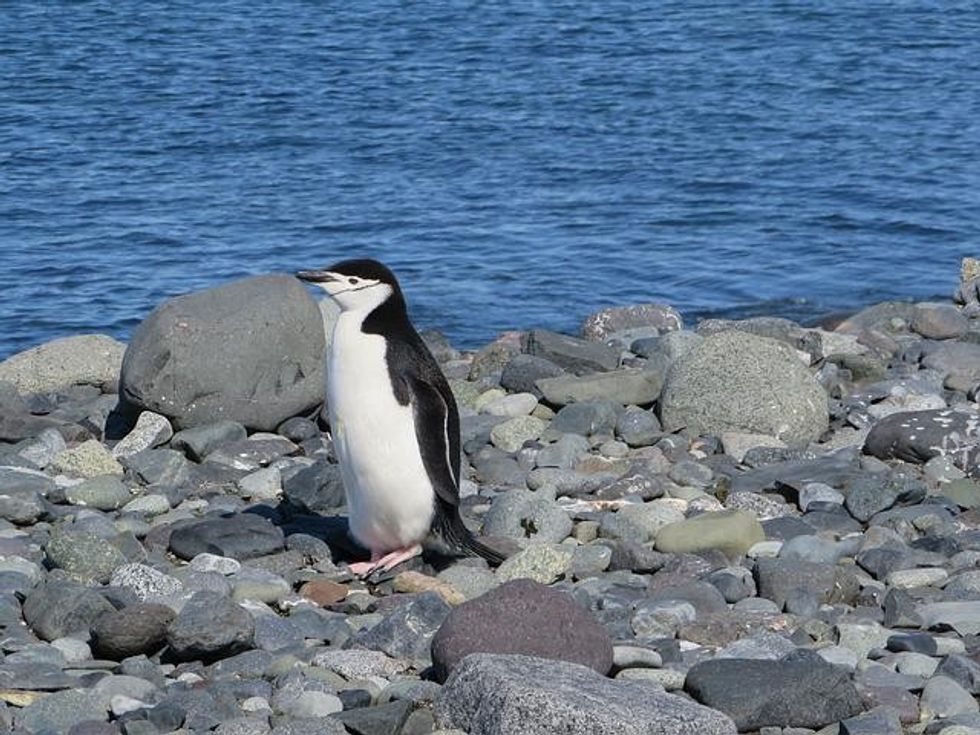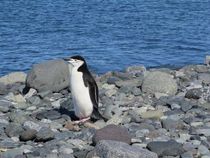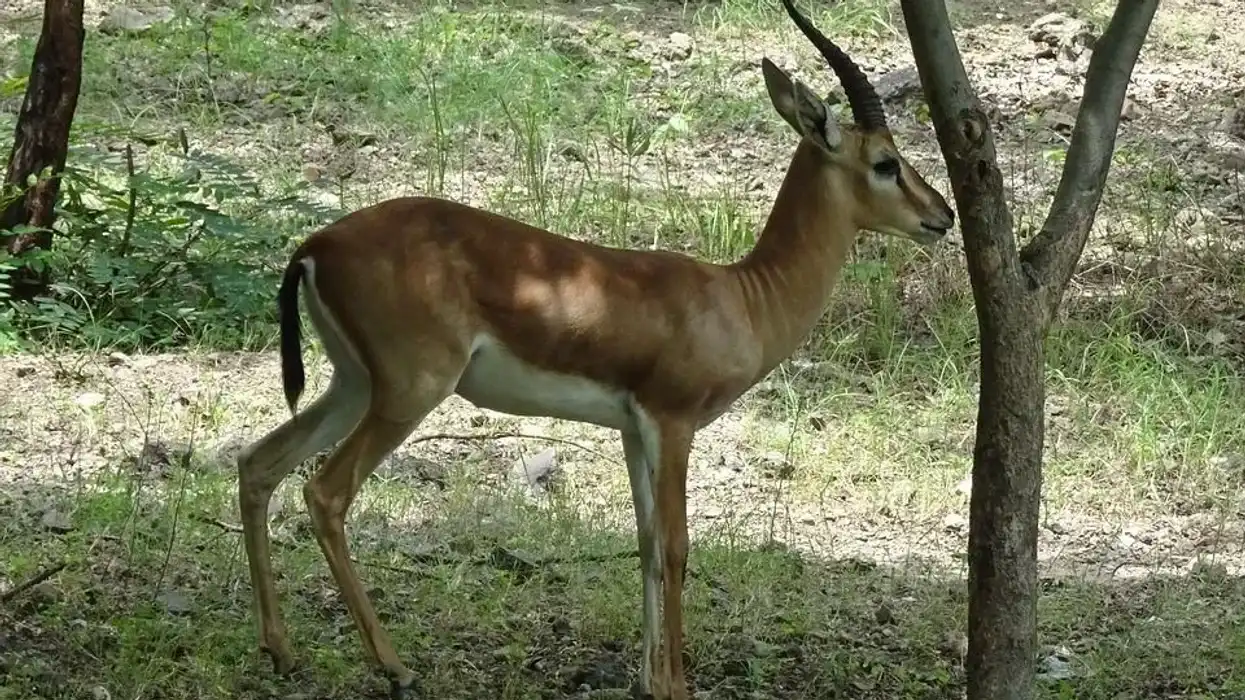Fun Chinstrap Penguin Facts For Kids
The Chinstrap Penguin is a marine animal that is also known as the ringed penguin, bearded penguin, or stone cracker penguin. The chinstrap penguin's scientific name is Pygoscelis antarcticus, and it is sometimes referred to as P. antarctica, an early scientific name for the species. Its family name is Spheniscidae and it belongs to the Aves class.
Among 18 different penguin species, the Pygoscelis family comprises three identical penguins known as brush-tailed penguins. Chinstraps are louder and make more frequent calls than other brush-tailed penguins.
These chinstrap penguins are found mostly in islands below the equator and shores in the Southern Pacific and the Antarctic oceans. Like other penguin species, these chinstrap penguins have white fronts and black backs with black flippers and reddish eyes.
These can be distinguished from other penguins by the black-colored ring 'chinstrap' that can be seen from ear to ear around their bill. This feature gave them their common name as chinstrap penguins.
They can withstand the extreme cold temperatures of the Antarctic thanks to their thick layer of fat, known as blubber, and tightly packed, oily feathers. Read on to find some of the best facts about penguins for kids as well as some baby chinstrap penguin facts!
Chinstrap Penguin Interesting Facts
What type of animal is a Chinstrap penguin?
Chinstrap Penguins (Pygoscelis antarcticus) are flightless seabirds highly adapted for life in the water. Chinstraps live on land as well as underwater. They can't fly across the sky, but they can swim at speeds of 50 mph (80 km/h) underwater, searching for prey. Instead of wings, these birds have flippers for swimming.
What class of animal does a Chinstrap penguin belong to?
Among 18 species, the chinstrap penguin is the smallest one, belonging to the Pygoscelis genus. Chinstraps are warm-blooded vertebrates belonging to the Aves class. These penguin birds found principally near the ocean, spend most of their time in the water.
How many Chinstrap penguins are there in the world?
Chinstraps are one of three species of brush-tail penguins, along with Adelie and Gentoo penguins. In 2018 the IUCN found approximately about 8 million mature individual chinstrap penguins globally made these penguins a Least Concern species. However, due to climate changes, this species' numbers are decreasing.
Where does a Chinstrap penguin live?
Chinstraps are found in Antarctica, Argentina, Bouvet Island, Chile, and the Falkland Islands. This penguin species has also been spotted in New Zealand, Saint Helena, Ascension and Tristan da Cunha, and South Africa. Chinstrap penguins also live in breeding colonies in the South Orkney Islands, South Shetland Islands, and the South Sandwich Islands.
What is a Chinstrap penguin's habitat?
Most chinstraps are found on large icebergs, on the sub-Antarctic region's barren islands, and the Antarctic Peninsula. These penguins' habitats are found in icy cold temperatures, on rocky or sandy islands. A thick layer of insulating feathers keeps them warm in these icy conditions and huddling is another way that these penguins stay warm and protect themselves from predators.
Who do Chinstrap penguins live with?
Chinstraps spend most of their lives in large groups called rookeries. These groups live, eat, swim, and nest together.
These large groups can sometimes include up to 1,000 penguins or more. This species primarily lives in the northern part of the Antarctic Peninsula and sub-Antarctic islands. Zavodovski Island, situated in the South Sandwich Islands in the Antarctic is the largest chinstrap penguin colony worldwide, covering up to one-seventh of its global population.
How long does a Chinstrap penguin live?
The average chinstrap penguin life span is between 15-20 years. Chinstrap penguins mainly prey on krill, but due to climate changes, a decrease in the krill population has threatened the long lives of these penguins. They also sometimes have to escape potential threats like volcanic eruptions and human hunting in order to complete the chinstrap penguin life cycle.
How do they reproduce?
Chinstraps spend the winter on icebergs and arrive in breeding colonies during October and November. Chinstrap penguins are monogamous, so they return to the same mate every year.
Male chinstraps beat their chests with their flippers and raise their heads and screech to display their mating interest. This action is echoed by other males, synchronizing the breeding season across a colony.
Male chinstraps arrive at breeding colonies five days before females and find shallow bowls in the rocks to build their nests in by adding rocks and bones to them. A chinstrap penguin nest is usually 15.7 in (40 cm) in diameter and 6 in (15 cm) in height.
After mating, breeding females lay two eggs between late November and early December. Both parents look after these two eggs and incubate the eggs in shifts of five days for five weeks.
These chicks hatch after roughly 37 days. Chicks emerge from their eggs in early January and remain in the nest for 20-30 days until February, before joining the young groups called 'creches'. During early March, these young penguins are prepared for adulthood, and are known as 'fledgings'.
After two months, the young chinstrap penguins molt and swim for the first time. They become sexually mature between ages three and seven and can live for as long as 20 years.
What is their conservation status?
There are estimated to be at least 8 million chinstrap penguins worldwide. Although their population is decreasing overall, their count is classified as stable due to their breeding pairs.
So, Pygoscelis antarctica is listed as Least Concern on the IUCN Red List.
The Antarctic Treaty of 1959 made it illegal to harm a penguin or its eggs and it is also made it mandatory to get approval before collecting penguin specimens by the Scientific Committee for Antarctic Research (SCAR). Appropriate management of tourism activities is also a must for these birds' conservation.
Chinstrap Penguin Fun Facts
What do Chinstrap penguin look like?
A chinstrap penguin has a large head, short neck, and elongated body with pink feet with black soles. They have short, stiff wedge-shaped tails.
To give these penguins an upright posture, their legs, and webbed feet are set far back from the body. The chinstrap penguin's black backs and white bellies form a camouflage.
When viewed from the top, black feathers above their heads, backs, and flippers help them merge with the ocean's darkness, and when viewed from below, their white bellies merge with the bright surface of the ocean. This countershading helps them escape becoming easy prey for their predators like the leopard seal.
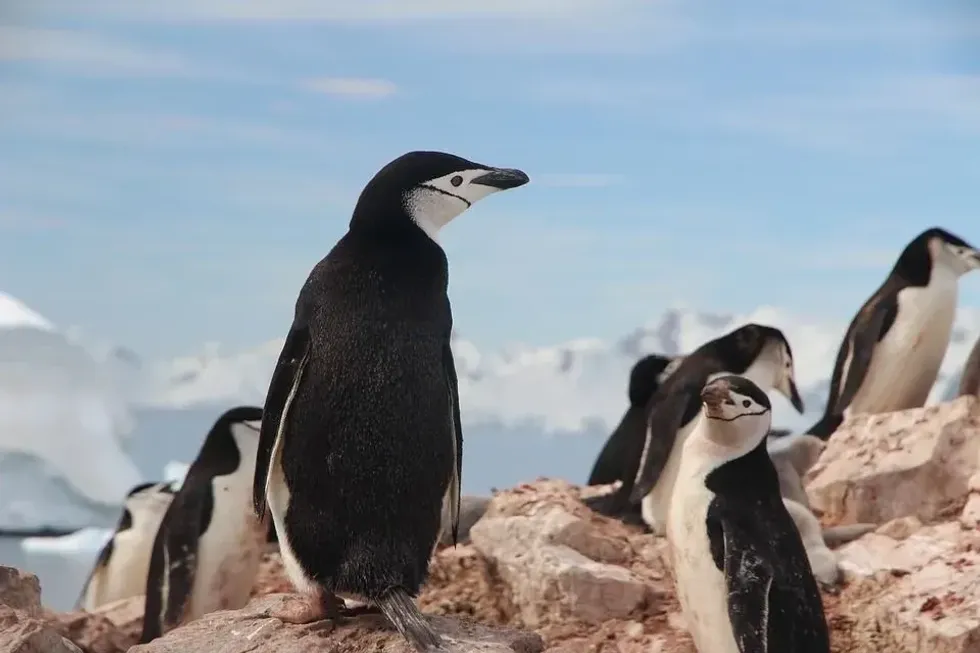
How cute are they?
Chinstraps can be cute to watch as they are delicately colored birds with white bellies with black backs. In contrast to other penguins, these penguins have a white face similar to that of royal penguins.
A thin dark line running under the lower part of the chin and around their head with tightly packed feathers makes them distinguishable from other penguins and makes them fascinating to watch. A chinstrap penguin chick is grey colored until 14 months of age, and these baby penguins are particularly cute!
How do they communicate?
Chinstrap penguins are social animals. During the breeding season, they are more vocal in their colonies.
They communicate by waving their heads and flippers, bowing, gesturing, and preening their coats. During a territorial dispute, they sometimes stare, point, and even charge at each other. These penguins make sounds like "kauk, kauk, kauk" while raising their flippers and moving their head from side to side.
How big is a Chinstrap penguin?
Generally, a penguin's average height ranges from about 14-45 in (36-114 cm), with weight varying from 2-90 lb (0.9-41 kg). The emperor penguin is the largest, whereas chinstraps are medium-sized penguins at 27–30 in (68–76 cm) tall with an average weight of 7.1–11.7 lb (3.2–5.3 kg).
Can a Chinstrap penguin fly?
Penguins belong to the bird family but they do not have wings to fly high, and so are known as flightless birds. Like other penguins, chinstrap penguins can't fly but use their flippers to swim at great speeds underwater up to 20 mph (32 km/h) in the ocean.
They waddle with their stomach forward, thrusting themselves forward using their feet and flippers on land.
How much does a Chinstrap penguin weigh?
They weigh about 7.1–11.7 lb (3.2–5.3 kg) and these penguins vary in weight with the time of year. Unlike other penguins, male and female chinstrap penguins are roughly the same size and almost resemble one another.
What are their male and female names of the species?
Like other penguins, adult male chinstrap penguins are called 'cocks', and female chinstrap penguins are called 'hens', and a group of penguins on land is called a 'waddle', and 'raft' is the name for a group of penguins in the water.
What would you call a baby Chinstrap penguin?
A female penguin will lay two eggs, and these eggs hatch after 37 days of incubation. A chinstrap penguin baby is called a chick, sometimes referred to as 'nestlings'.
A group of chicks is called a 'crèche' and these groups of chicks like to cuddle together for warmth and protection. After two months, a baby penguin's fuzzy feathers are outmoded by waterproof feathers.
What do they eat?
About 95–99% of the chinstrap penguin diet consists mainly of krill. They also consume crustaceans, shrimp, small fishes, and squid, but their favorite is krill. Adult penguins can dive as deep as 330 ft (100 m) every day to obtain food but mainly catch prey within 150–165 ft (46–50 m).
Are Chinstrap penguins aggressive?
Chinstrap penguins are the most aggressive and ill-tempered among all penguins.
Would they make a good pet?
Chinstrap penguins love to live and breed in large colonies on islands. They can't be adopted as pets as they love to live in the wild together in colonies.
Did you know...
The Chinstrap Penguin colony on Zavodovski Island in the South Atlantic Ocean is estimated to have 1.2 million breeding pairs. It is declared the largest penguin colony in the world by the Guinness Book of World Records.
Having learned about the best chinstrap penguin facts, are you planning to visit these species of penguin? Well, it might be an unpleasant tour!
It is said that the largest colony of these penguins can be the smelliest place on earth. These islands, with more than a million breeding pairs of penguins, can be a very smelly place.
In addition to penguin droppings, sulfuric air from an active volcano on these islands also produces deadly smells. Hence the island that is home to the largest colony of chinstrap penguins is also known as Stench Point, Pungent Point, and Noxious Bluff!
Is the Chinstrap penguin endangered?
The main chinstrap penguin predators in the sea are leopard seals. Due to the leopard seal, there has been a decrease in the penguins' population by 5%-20% on Chinstrap Penguin Island.
On land, the brown skua, South Polar skua, Southern giant petrel, and the Antarctic fur seal are the biggest predators of chinstrap penguin eggs and chicks.
Despite these predators, the chinstrap is not endangered, in fact, the International Union for Conservation of Nature (IUCN) Red List classifies them as the status Least Concern. These penguin birds (as well as their eggs and chicks) are legally protected from hunting and egg collecting by humans.
Do Chinstrap penguins mate for life?
Chinstrap penguins are monogamous, almost always returning to the same mate every year. After spending the winter in the icy islands where they huddle together for warmth, they return to nesting lands each year to form colonies in early October to November.
According to research, 82% of chinstrap penguins generally pair with the previous year's mate.
However, a female can select a different mate if her mate from the previous season fails to return to the nesting area. In such scenarios, both male and female penguins may obtain new mates.
Here at Kidadl, we have carefully created many interesting family-friendly animal facts for everyone to discover! You can even occupy yourself at home by drawing one on our baby penguin coloring pages.
We Want Your Photos!
More for You
See All
Master of Computer Science

Abhijeet ModiMaster of Computer Science
An experienced and innovative entrepreneur and creative writer, Abhijeet holds a Bachelor's and Master's degree in Computer Application from Birla Institute of Technology, Jaipur. He co-founded an e-commerce website while developing his skills in content writing, making him an expert in creating blog posts, website content, product descriptions, landing pages, and editing articles. Passionate about pushing his limits, Abhijeet brings both technical expertise and creative flair to his work.
Disclaimer
1) Kidadl is independent and to make our service free to you the reader we are supported by advertising. We hope you love our recommendations for products and services! What we suggest is selected independently by the Kidadl team. If you purchase using the Buy Now button we may earn a small commission. This does not influence our choices. Prices are correct and items are available at the time the article was published but we cannot guarantee that on the time of reading. Please note that Kidadl is a participant in the Amazon Services LLC Associates Program, an affiliate advertising program designed to provide a means for sites to earn advertising fees by advertising and linking to Amazon. We also link to other websites, but are not responsible for their content.
2) At Kidadl, we strive to recommend the very best activities and events. We will always aim to give you accurate information at the date of publication - however, information does change, so it’s important you do your own research, double-check and make the decision that is right for your family. We recognise that not all activities and ideas are appropriate for all children and families or in all circumstances. Our recommended activities are based on age but these are a guide. We recommend that these ideas are used as inspiration, that ideas are undertaken with appropriate adult supervision, and that each adult uses their own discretion and knowledge of their children to consider the safety and suitability. Kidadl cannot accept liability for the execution of these ideas, and parental supervision is advised at all times, as safety is paramount. Anyone using the information provided by Kidadl does so at their own risk and we can not accept liability if things go wrong.
3) Because we are an educational resource, we have quotes and facts about a range of historical and modern figures. We do not endorse the actions of or rhetoric of all the people included in these collections, but we think they are important for growing minds to learn about under the guidance of parents or guardians.
